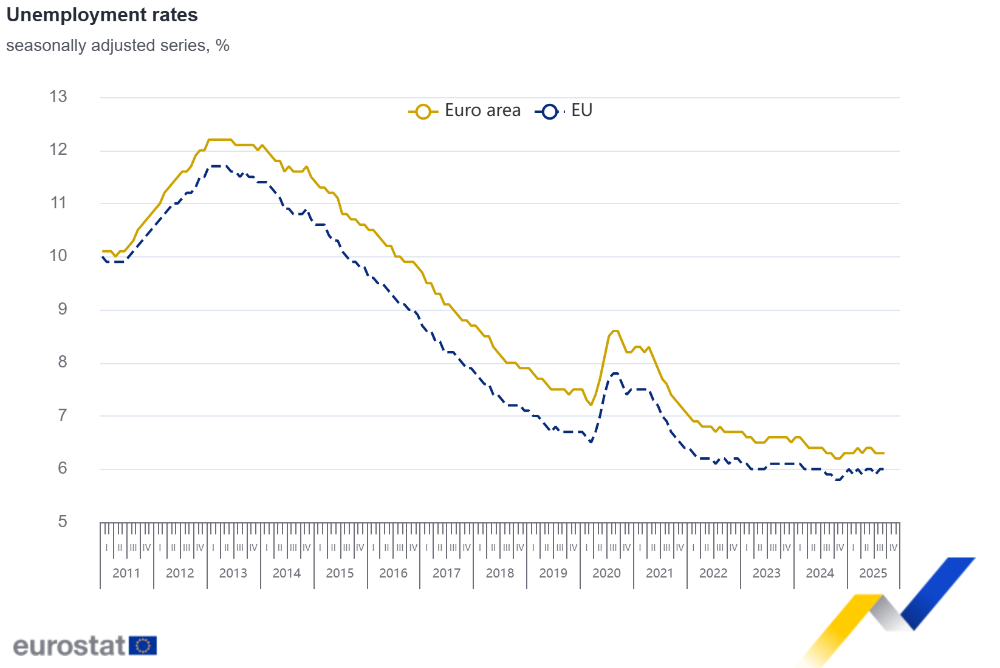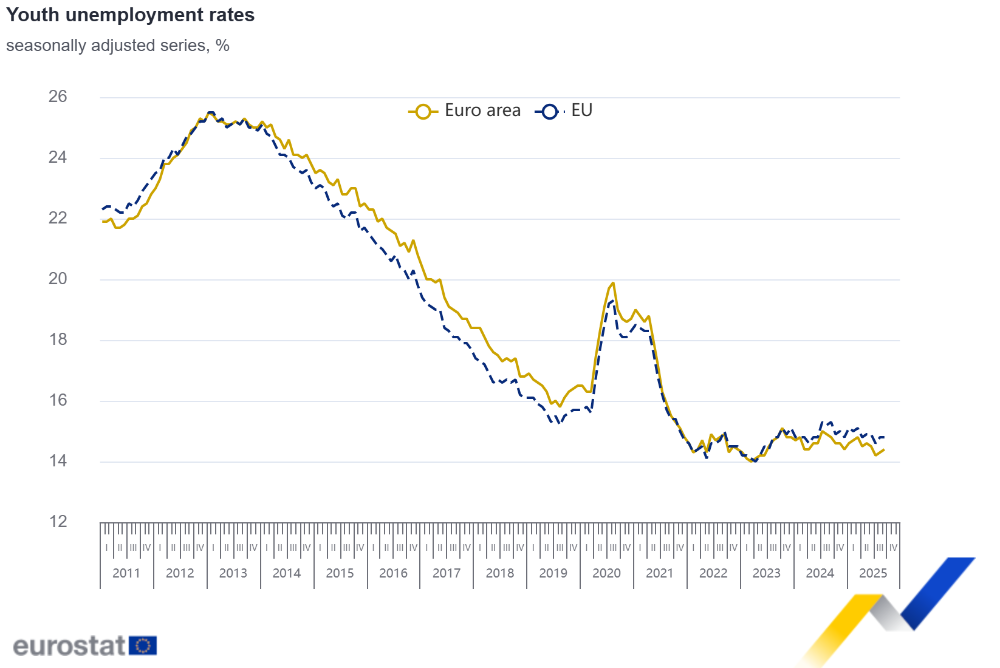Overview
In September 2025, the euro area seasonally adjusted unemployment rate was 6.3%, stable compared with August 2025 as well as with September 2024. The EU unemployment rate was 6.0% in September 2025, also stable compared with August 2025 and up from 5.9% in September 2024. These figures are published by Eurostat, the statistical office of the European Union.
Eurostat estimates that 13.246 million persons in the EU, of whom 11.003 million in the euro area, were unemployed in September 2025.
Compared with August 2025, unemployment increased by 63 thousand in the EU and by 65 thousand in the euro area.
Compared with September 2024, unemployment increased by 227 thousand in the EU and by 187 thousand in the euro area.

Youth unemployment
In September 2025, 2.866 million young persons (under 25) were unemployed in the EU, of whom 2.282 million were in the euro area. In September 2025, the youth unemployment rate was 14.8% in the EU, stable compared with August 2025, and 14.4% in the euro area, up from 14.3% in the previous month.
Compared with August 2025, youth unemployment increased by 10 thousand in the EU and by 23 thousand in the euro area.
Compared with September 2024, youth unemployment decreased by 121 thousand in the EU and by 79 thousand in the euro area.

Unemployment by sex
In September 2025, the unemployment rate for women was 6.1% in the EU and the unemployment rate for men was 5.8%, both stable compared with the previous month. In the euro area, the unemployment rate for women was 6.5%, stable compared with August 2025, and the unemployment rate for men was 6.2%, up from 6.1% in the previous month.
Additional labour market indicators
The estimates in this News Release are based on the globally used International Labour Organisation (ILO) standard definition of unemployment, which counts as unemployed people without a job who have been actively seeking work in the last four weeks and are available to start work within the next two weeks.
To capture in full the labour market situation, the data on unemployment have been complemented by additional indicators, e.g. underemployed part-time workers, persons seeking work but not immediately available and persons available to work but not seeking, released together with EU Labour Force Survey (EU-LFS) data for the second quarter of 2025.
EU-LFS data for the third quarter of 2025 will be released on 12 December 2025.
Tables
Seasonally adjusted unemployment, totals
Rates (%)
Number of persons (in thousands)
2024
2025
2024
2025
Sep
Jun
Jul
Aug
Sep
Sep
Jun
Jul
Aug
Sep
6.3
6.4
6.3
6.3
6.3
10 816
11 024
10 909
10 938
11 003
5.9
6.0
5.9
6.0
6.0
13 019
13 238
13 128
13 183
13 246
5.8
6.0
5.9
5.8
5.9
309
330
322
317
324
4.0
3.6
3.7
3.6
3.5
122
109
111
109
106
3.0
3.0
2.8
3.1
3.0
154
161
152
167
160
6.7
6.7
6.5
6.4
6.1
219
220
214
208
202
3.4
3.8
3.8
3.8
3.9
1 513
1 666
1 681
1 696
1 711
8.1
7.3
8.0
7.5
7.4
61
56
61
56
56
4.1
4.6
4.8
4.7
4.7
119
134
143
139
138
9.7
9.1
8.4
8.2
8.2
456
434
397
386
386
11.1
10.5
10.6
10.5
10.5
2 708
2 617
2 621
2 612
2 606
7.4
7.5
7.5
7.5
7.6
2 327
2 396
2 395
2 390
2 421
5.0
4.7
4.7
4.7
4.7
89
83
82
83
83
6.1
6.3
6.0
6.0
6.1
1 566
1 615
1 541
1 550
1 582
4.6
4.7
5.0
5.1
4.9
24
25
26
27
26
6.8
6.6
6.6
6.5
6.4
64
63
62
62
61
7.2
7.1
7.1
7.0
7.0
114
111
111
110
108
6.5
6.7
6.6
6.6
6.9
23
23
23
23
24
4.5
4.4
4.3
4.3
4.5
221
215
212
211
219
3.1
2.9
2.9
2.9
3.0
10
10
10
10
10
3.7
3.8
3.8
3.9
4.0
377
386
388
401
409
5.6
5.9
5.5
5.9
5.5
266
282
260
277
262
3.0
3.1
3.1
3.2
3.2
527
542
551
562
569
6.5
5.9
5.8
5.9
6.0
356
329
324
333
337
5.7
6.0
5.8
5.9
5.9
466
490
471
481
482
4.2
3.1
3.0
2.9
3.1
43
32
30
30
31
5.3
5.3
5.4
5.4
5.5
145
147
148
148
150
8.6
9.5
9.6
9.7
9.8
244
271
275
278
279
8.5
8.7
8.7
8.7
8.7
489
502
502
503
504
3.4
3.8
3.8
3.9
3.9
8
9
9
9
9
4.0
4.6
4.7
4.7
4.7
121
140
142
143
144
4.6
4.8
:
:
:
235
249
:
:
:
4.1
4.1
4.2
4.3
:
6 788
7 008
7 214
7 388
:
Seasonally adjusted youth (under 25s) unemployment
Rates (%)
Number of persons (in thousands)
2024
2025
2024
2025
Sep
Jun
Jul
Aug
Sep
Sep
Jun
Jul
Aug
Sep
14.8
14.5
14.2
14.3
14.4
2 361
2 315
2 261
2 259
2 282
15.3
14.9
14.6
14.8
14.8
2 987
2 905
2 836
2 856
2 866
18.2
15.3
13.8
13.8
13.8
80
72
60
60
60
11.3
14.9
15.8
15.2
14.5
12
18
19
18
17
11.7
11.2
10.8
10.2
10.2
32
37
35
32
33
15.6
14.8
12.1
15.1
13.9
80
78
59
73
68
6.8
6.7
6.7
6.7
6.7
310
308
307
306
306
19.4
26.3
25.1
21.1
20.6
11
18
18
14
14
10.5
11.3
12.2
12.1
12.2
39
41
45
45
45
19.2
18.8
19.6
17.8
18.5
46
50
47
48
41
26.1
24.7
24.9
24.9
25.0
473
456
459
461
467
20.0
18.6
18.2
18.1
18.3
676
637
626
622
632
16.8
17.0
16.7
16.7
16.7
20
20
20
20
20
18.9
20.3
19.1
19.7
20.6
270
271
254
252
271
11.2
14.7
17.2
17.2
17.2
4
4
5
5
5
12.4
16.9
17.0
17.3
17.6
8
12
12
12
13
18.3
16.1
16.5
15.1
15.2
20
15
15
13
13
20.9
20.6
20.2
19.9
20.9
6
5
5
5
6
16.8
13.8
13.7
15.0
14.4
53
41
41
45
42
10.7
8.9
9.4
9.2
10.1
3
2
2
2
3
9.0
8.7
8.4
8.6
8.8
161
157
151
156
159
9.9
13.7
10.0
12.3
11.9
53
73
50
61
63
10.8
12.7
12.8
12.9
13.0
126
138
140
142
144
21.0
18.9
19.5
18.8
18.1
79
72
76
72
69
26.7
23.5
:
:
:
145
119
:
:
:
13.8
11.4
12.2
12.2
12.2
11
8
7
7
7
17.5
15.5
15.6
15.6
16.2
25
21
21
21
22
19.1
21.3
21.7
21.7
21.5
62
69
69
70
69
24.3
23.8
23.9
23.9
24.0
165
165
166
166
167
8.7
8.3
8.4
8.5
8.6
3
3
3
3
3
12.6
15.9
13.7
18.3
14.5
55
74
61
84
63
9.0
8.6
:
:
:
53
52
:
:
:
Seasonally adjusted unemployment rates (%), by sex
Males
Females
2024
2025
2024
2025
Sep
Jun
Jul
Aug
Sep
Sep
Jun
Jul
Aug
Sep
6.1
6.2
6.1
6.1
6.2
6.5
6.6
6.5
6.5
6.5
5.7
5.9
5.8
5.8
5.8
6.1
6.1
6.1
6.1
6.1
6.1
6.7
6.6
6.6
6.7
5.4
5.1
5
4.9
5.1
4.3
3.8
3.9
3.8
3.7
3.7
3.4
3.4
3.3
3.3
2.7
2.8
2.5
2.7
2.6
3.3
3.3
3.2
3.6
3.4
6.3
7.2
7.1
6.4
6.3
7.1
6.1
6
6.3
6
3.6
4.1
4.2
4.2
4.2
3.2
3.4
3.4
3.4
3.5
8.2
7.3
8.8
8.7
8.7
7.9
7.3
7.1
6.2
6.1
4.1
4.8
5.0
4.9
4.8
4.2
4.3
4.7
4.5
4.5
7.9
7.6
6.5
6.1
6.0
11.9
11
10.8
10.7
10.9
10.0
9.3
9.2
9.1
9.0
12.3
11.9
12
12.1
12.1
7.7
7.8
7.7
7.8
7.8
7.2
7.3
7.3
7.2
7.3
5.1
5.0
4.9
5.0
4.9
4.9
4.4
4.3
4.3
4.4
5.6
5.7
5.5
5.6
5.8
6.9
7
6.7
6.7
6.6
4.5
4.2
4.5
4.7
4.7
4.7
5.2
5.5
5.5
5.2
8.3
6.8
6.9
7.0
7.0
5.4
6.4
6.2
6
5.9
8.1
7.7
7.6
7.5
7.4
6.4
6.5
6.6
6.6
6.5
6.6
6.6
6.6
6.6
6.8
6.5
6.7
6.6
6.5
6.9
4.6
4.5
4.4
4.3
4.6
4.4
4.3
4.2
4.4
4.3
3.1
3.0
3.0
3.0
3.1
3.1
2.7
2.7
2.6
2.8
3.5
3.7
3.7
3.8
3.8
3.9
3.9
3.9
4
4.2
6.0
6.3
5.6
6.4
5.9
5.1
5.5
5.3
5.3
5
2.7
2.8
2.8
2.9
2.9
3.3
3.4
3.5
3.5
3.6
6.2
5.5
5.6
5.7
5.4
6.9
6.3
6
6.2
6.6
6.2
6.0
6.0
6.2
6.1
5.1
6
5.5
5.5
5.6
4.0
3.2
3.0
3.0
3.2
4.4
3
2.9
2.8
2.9
4.7
5.1
5.1
5.1
5.2
5.9
5.6
5.6
5.7
5.7
9.4
10.2
10.4
10.5
10.5
7.8
8.7
8.8
8.9
8.9
8.3
8.7
8.8
8.8
8.8
8.8
8.7
8.7
8.6
8.6
3.5
4.0
4.1
4.2
4.2
3.2
3.5
3.5
3.5
3.6
4.2
5.8
4.7
5.2
5.1
3.8
5.1
4.2
4.6
4.4
4.4
4.8
:
:
:
4.8
4.9
:
:
:
Notes for users
Revisions and timetable
The data in this News Release can be subject to revisions, caused by updates to the seasonally adjusted series whenever new monthly data are added; the inclusion of the most recent EU-LFS data in the calculation process; update of seasonal adjustment models with complete annual data.
Compared with the rates published in News Release of 2 October 2025, the August 2025 unemployment rate for the euro area remained unchanged, while the unemployment rate for the EU has been revised from 5.9% to 6.0%. Among EU Member States, the rate has been revised by more than 0.1 percentage points (pp) downwards for Estonia (by 0.7 pp) and Portugal (by 0.2 pp). The rate has been revised by more than 0.1 percentage points (pp) upwards for Spain (by 0.2 pp).
Country notes
Germany, the Netherlands, Finland, Sweden as well as Iceland and Norway: the trend component is used instead of the more volatile seasonally adjusted data.
Estonia and Portugal: 3-month moving averages of EU-LFS data are used instead of pure monthly indicators.
Methods and definitions
Eurostat publishes harmonised unemployment rates for individual EU Member States, the euro area and the EU. These unemployment rates are based on the definition recommended by the International Labour Organisation (ILO). The measurement is based on a harmonised data source, the European Union Labour Force Survey (EU-LFS).
Based on the ILO definition, Eurostat defines unemployed persons as persons aged 15 to 74 who:
The unemployment rate is the number of people unemployed as a percentage of the labour force.
The labour force is the total number of people employed plus unemployed. In this news release unemployment rates are based on employment and unemployment data covering persons aged 15 to 74.
The youth unemployment rate is the number of people aged 15 to 24 unemployed as a percentage of the labour force of the same age. Therefore, the youth unemployment rate should not be interpreted as the share of jobless people in the overall youth population.
When data for the most recent month are not available for a Member State, EU and EA aggregates are calculated using the latest data available for that Member State.
Geographical information
Euro area (EA20): Belgium, Germany, Estonia, Ireland, Greece, Spain, France, Croatia, Italy, Cyprus, Latvia, Lithuania, Luxembourg, Malta, the Netherlands, Austria, Portugal, Slovenia, Slovakia and Finland.
European Union (EU27): Belgium, Bulgaria, Czechia, Denmark, Germany, Estonia, Ireland, Greece, Spain, France, Croatia, Italy, Cyprus, Latvia, Lithuania, Luxembourg, Hungary, Malta, the Netherlands, Austria, Poland, Portugal, Romania, Slovenia, Slovakia, Finland and Sweden.
For more information

